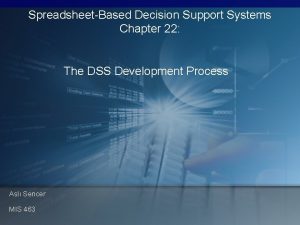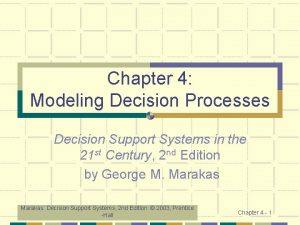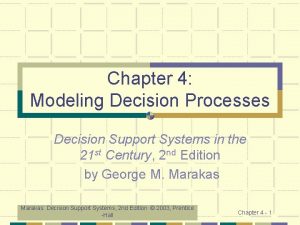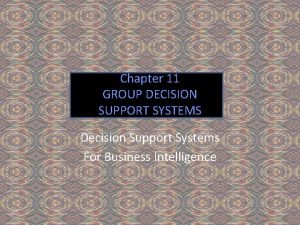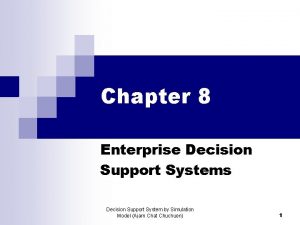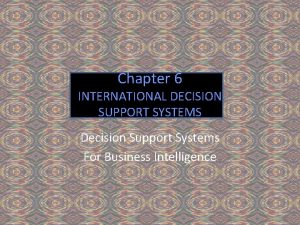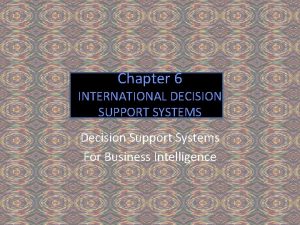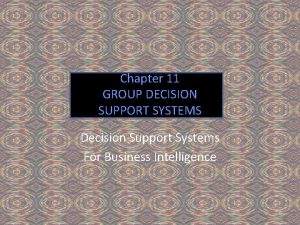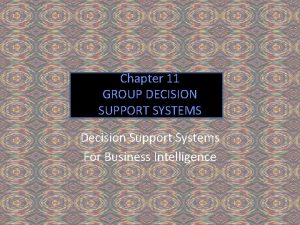Chapter 4 Modeling Decision Processes Decision Support Systems









- Slides: 9

Chapter 4: Modeling Decision Processes Decision Support Systems in the 21 st Century, 2 nd Edition by George M. Marakas: Decision Support Systems, 2 nd Edition © 2003, Prentice -Hall Chapter 4 - 1

4 -1: Defining the Problem and Its Structure A fully formed problem statement contains three key components: • The current state of affairs • The desired state of affairs • A statement of the central objective(s) that distinguish the two Marakas: Decision Support Systems, 2 nd Edition © 2003, Prentice-Hall Chapter 4 - 2

Problem Definition Errors Failing to identify and define the problem fully may result in a great solution that does not solve the right problem A common error: premature focus on the set of solutions rather than the problem itself The decision maker may be left with a solution looking for a problem to solve Marakas: Decision Support Systems, 2 nd Edition © 2003, Prentice-Hall Chapter 4 - 3

Problem Scope The problem may be worth solving but the scope is beyond the available resources or time constraints In such cases, the scope must be reduced to a focus that allows a solution One method to limit the scope is to identify its breadth by asking questions about people involved, cost and magnitude Marakas: Decision Support Systems, 2 nd Edition © 2003, Prentice-Hall Chapter 4 - 4

Problem Structure Design of problem structure is similar to design of many other entities l What is the final appearance? l What are the elemental details? l What are the relationships between those elements? Regardless of context, a problem structure can be described in terms of choices, uncertainties and objectives Marakas: Decision Support Systems, 2 nd Edition © 2003, Prentice-Hall Chapter 4 - 5

Problem Structure (cont. ) Choices: there always at least two alternatives (one is “do nothing”) Uncertainties: situations beyond the direct control of the decision maker; their individual probability of occurrence is only estimable within a certain range Objectives: methods of establishing the criteria used to measure the value of the outcome Marakas: Decision Support Systems, 2 nd Edition © 2003, Prentice-Hall Chapter 4 - 6

Structuring Tools Influence diagram: a simple method of graphing the components of a decision and linking them to show the relationships between them Uncertainty Decision Marakas: Decision Support Systems, 2 nd Edition © 2003, Prentice-Hall Objective Chapter 4 - 7

Structuring Tools (cont. ) Decision tree: another diagram that models choices and uncertainties and can be extended to include multiple, sequential decisions Uncertainty Decision Marakas: Decision Support Systems, 2 nd Edition © 2003, Prentice-Hall Chapter 4 - 8

Common Decision Structures Basic Risky Decision: decision maker takes a choice in the face of uncertainty. Success is a function of the choice and outcome. Certainty: a multiple-objective decision with little risk. Success is a function of the tradeoff between objectives. Sequential: several risky decisions over time. Earlier outcomes may affect later choices. Marakas: Decision Support Systems, 2 nd Edition © 2003, Prentice-Hall Chapter 4 - 9
 Decision support systems and intelligent systems
Decision support systems and intelligent systems Helen c. erickson
Helen c. erickson Dimensional modeling vs relational modeling
Dimensional modeling vs relational modeling Decision support and business intelligence systems
Decision support and business intelligence systems Developing spreadsheet-based decision support systems
Developing spreadsheet-based decision support systems Decision support and business intelligence systems
Decision support and business intelligence systems Decision support and expert systems
Decision support and expert systems Concurrent in os
Concurrent in os Objectives of decision making
Objectives of decision making Financial management process
Financial management process




